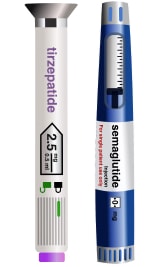- What Is the Duodenal Switch?
- Duodenal Switch Benefits
- Duodenal Switch Candidates
- Duodenal Switch Procedure
- Duodenal Switch Complications
- Duodenal Switch Recovery
- Duodenal Switch Cost
What Is the Duodenal Switch?
The duodenal switch, also known as biliopancreatic diversion with duodenal switch (BPD/DS), or (SADI), is a type of weight loss surgery that combines two surgical techniques: sleeve gastrectomy and intestinal bypass. This procedure is designed to help people with severe obesity lose a significant amount of weight and improve obesity-related health conditions.
Duodenal Switch (DS) or (SADI) is designed to limit food intake as well as encourage malabsorption of food by altering the digestive process. Medically referred to as biliopancreatic diversion with duodenal switch (BPD), or single anastomosis duodenal ileostomy, this procedure can be ideal for those with severe morbid obesity, defined as a body mass index (BMI) of 50 or higher, and/or individuals who struggle with weight-related diseases, such as high cholesterol or diabetes. Our experienced, board-certified Chicago bariatric surgeons, who are Fellows of the American Society for Metabolic and Bariatric Surgery, perform this complex procedure utilizing a fully robotic technique as a two-part approach.
The first step removes a portion of the stomach to restrict the amount of food for consumption, followed by dividing and rerouting the path to the small intestine to enable reduced calorie absorption. Weight loss with DS has shown to provide the greatest loss of excess weight compared to other procedures and can be highly effective for long-term results, with some patients having lost up to 81% of excess weight.* This procedure also has a significantly reduced risk of weight regain following surgery in the long run.
What are the Benefits of the Duodenal Switch?
For good candidates, the duodenal switch procedure can offer the greatest amount of excess weight loss when compared to other bariatric procedures. Potential benefits typically include:
- Significant Weight Loss: The duodenal switch can result in substantial and sustained weight loss — greater than any other bariatric procedure presently.
- Improved Health Conditions: Conditions such as type 2 diabetes, hypertension, sleep apnea, hyperlipidemia and the metabolic syndrome often improve or resolve.
- Improved Quality of Life: Patients often experience improved mobility and overall quality of life.
Patients undergoing duodenal switch under the Da Vinci surgical system can also enjoy the benefits of robotic surgery, which offers a less invasive surgery with a reduced period of downtime, shorter incisions, less conspicuous scarring, and a lower risk of bleeding and other complications. Typically, patients only stay overnight and are discharged the next day.
Who is a Candidate for the Duodenal Switch?
The duodenal switch procedure is typically most successful for severely obese men and women who are also affected by weight-related medical conditions like heart disease, Type 2 diabetes, high blood pressure, and high cholesterol. While often considered one of the most effective and successful weight loss surgeries available, this procedure is most commonly performed on individuals with particularly high BMIs. Good candidates for duodenal switch surgery generally:
- Have a BMI greater than 50 that causes metabolic health conditions, such as diabetes, hyperlipidemia, high blood cholesterol, etc.
- Cannot achieve their health and weight loss goals with dieting and exercise alone
- Are willing to adhere to lifelong dietary restrictions and take nutritional supplements for the rest of their lives
- Have had significant weight regain following other bariatric procedures
If you’re affected by GERD (gastroesophageal reflux disease) or inflammatory bowel disease (IBD), it’s important to speak with a bariatric surgeon about whether duodenal switch is the right solution for you. Patients who have dietary restrictions, such as vegans and vegetarians, are also usually at a higher risk of a protein deficiency after duodenal switch, so discussing your unique needs with one of our qualified bariatric surgeons can help identify the best treatment for you.
What Does the Duodenal Switch Procedure Involve?
Our skilled surgeons perform the DS procedure fully robotically with the Da Vinci platform using tiny surgical instruments inserted through small incisions in the abdomen. This technique can be used to reduce the stomach size by removing about three-quarters of the stomach pouch through a Vertical Sleeve Gastrectomy. This restricts the amount of food that the stomach is able to store and, therefore, how much you are able to comfortably consume. The small intestine is also operated on to influence less calorie and nutrient absorption.
The duodenum, which is the first section of the small intestine, is divided and redirected to the new stomach pouch. As a result, pancreatic and bile drainage is bypassed, causing the digestive juices and food to reach each other farther down in the intestine, which ultimately limits your ability to absorb calories.
This combination of decreasing the stomach size and causing malabsorption of calories allows for the highest weight loss potential.
Here’s an overview of the duodenal switch:
Procedure Components
1.Sleeve Gastrectomy:
- A large portion of the stomach is removed, leaving a smaller, tube-shaped stomach (sleeve).
- This limits the amount of food that can be eaten at one time and reduces the production of the hunger hormone ghrelin.
2. Intestinal Bypass:
- The small intestine is divided into two parts. One part (the biliopancreatic limb) carries bile from the liver, and the other part (the alimentary limb) carries food from the stomach.
- These two limbs are connected to create a common channel where food and digestive juices mix before entering the large intestine.
- This bypass reduces the length of the intestine that comes in contact with food, decreasing the absorption of calories and nutrients.
What Complications Are Associated with the Duodenal Switch?
Although DS can be very effective for long-term weight loss and health improvements, the procedure is complex and may involve slightly more risk, depending on the patient’s health history. General risks associated with bariatric surgeries may include wound infection, incisional hernia, internal bleeding, reactions to anesthesia, and traveling blood clots. More specifically, DS surgery has a greater potential to develop deficiencies in a number of vitamins and minerals (calcium, iron, zinc, vitamins A and D, and more), which can eventually lead to anemia, kidney stones, and osteoporosis due to malabsorption. Typically taking a 1-a-day bariatric vitamin is sufficient to avoid any vitamin deficiencies. Patients should also be aware of their increased protein requirements as insufficient amounts in severe cases may cause protein-energy malnutrition. Our surgeons and medical team work closely with patients to educate them about any possible risks and mitigate the potential for complications.
What Is the Recovery Time After Duodenal Switch Surgery?
Following the DS procedure, a one-night hospital stay is required to monitor the rerouted digestive system and ensure everything is functioning properly. Fortunately, the advanced nature of performing the surgery robotically usually leads to a shorter recovery time, with most patients returning to work and normal daily routines after about one to two weeks. More strenuous or unrestricted activities can usually resume one month post-surgery, around the same time as the follow-up appointment to review the healing and weight loss progress. It is imperative to attend all follow-up visits and observe post-operation instructions that include dietary and supplement guidelines for a safe and successful recovery.
How Much Does the Duodenal Switch Cost?
In the Chicago, Illinois area, the duodenal switch procedure generally depends on individual factors that vary from patient to patient. Your cost estimate is calculated based on several key factors, including:
- Your bariatric surgeon’s experience
- The nature of the procedure, such as whether surgery is performed on an inpatient or outpatient basis
- Hospital or surgical facility fees
- The costs of anesthesia, pre-operative testing, post-operative care, and insurance coverage
Additional expenses may include nutritional counseling, follow-up visits, and necessary supplements due to long-term malabsorption effects. Insurance coverage plays a major role in affordability, and some plans may cover part or all of the surgery. This often depends on whether a patient meets the necessary medical criteria, such as a high BMI and/or related co-morbidities like diabetes or hypertension. For out-of-pocket costs, patient financing through Prosper® Healthcare Lending is available for qualified patients.
Schedule a Consultation
To learn more about the duodenal switch procedure, or to schedule a consultation with one of our bariatric surgeons, please contact Suburban Surgical Care Specialists/Kane Center today.
Medical Reference for Duodenal Switch:
*Healthline: Is Duodenal Switch Surgery Safe and Effective for Long-Term Weight Loss?



